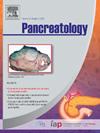Outcomes of FOLFIRINOX versus gemcitabine plus nab-paclitaxel in patients with early recurrent pancreatic cancer after adjuvant S-1 treatment: A propensity score-matched analysis
IF 2.7
2区 医学
Q2 GASTROENTEROLOGY & HEPATOLOGY
引用次数: 0
Abstract
Background
Oral fluoropyrimidine, S-1 is the standard adjuvant chemotherapy for patients with resected pancreatic cancer (PC) in Japan. Patients experiencing early recurrence are typically treated with 5-fluorouracil, leucovorin, irinotecan, and oxaliplatin (FOLFIRINOX) or gemcitabine plus nab-paclitaxel (GnP), which are commonly used in patients with advanced PC. However, no clinical studies have compared these regimens in this particular population.
Methods
This multicenter retrospective study included PC patients who experienced recurrence within six months of the last S-1 administration, including those who had recurrence during the treatment. Patients were treated with either FOLFIRINOX or GnP between December 2013 and 2018. The primary endpoint was overall survival (OS), with secondary endpoints of progression-free survival (PFS), objective response, and serious adverse events (SAEs). Propensity score-matched (PSM) analysis was performed to reduce potential confounding factors between the two groups.
Results
A total of 284 patients from 32 institutions were enrolled. After PSM, 43 patients from each group were compared. Some patient characteristics remained imbalanced between the matched pairs. The GnP group was associated improved OS compared to FOLFIRINOX group (median, 14.5 vs. 11.1 months; hazard ratio [HR], 0.61; 95 % confidence interval [CI], 0.38–0.97). While PFS tended to be longer in the GnP group (median, 7.1 vs. 5.1 months), this difference did not reach statistical significance (HR, 0.65; 95 % CI, 0.41–1.02). The objective response and observed SAEs in the GnP/FOLFIRINOX groups were 20/19 % and 14/19 % respectively.
Conclusions
GnP was associated with improved OS compared to FOLFIRINOX for patients with early recurrence after adjuvant S-1.
辅助S-1治疗后早期复发胰腺癌患者的FOLFIRINOX与吉西他滨加nab-紫杉醇的结局:倾向评分匹配分析
背景:口服氟嘧啶S-1是日本胰腺癌切除术(PC)患者的标准辅助化疗方案。早期复发的患者通常使用5-氟尿嘧啶、亚叶酸钙、伊立替康和奥沙利铂(FOLFIRINOX)或吉西他滨加nab-紫杉醇(GnP)治疗,这两种药物通常用于晚期PC患者。然而,没有临床研究在这一特定人群中比较这些方案。方法:这项多中心回顾性研究纳入了最后一次S-1给药后6个月内复发的PC患者,包括治疗期间复发的患者。患者在2013年12月至2018年期间接受FOLFIRINOX或GnP治疗。主要终点是总生存期(OS),次要终点是无进展生存期(PFS)、客观反应和严重不良事件(SAEs)。采用倾向评分匹配(PSM)分析,减少两组间潜在的混杂因素。结果:共纳入来自32家机构的284例患者。经PSM治疗后,两组各比较43例。一些患者的特征在配对组之间仍然不平衡。与FOLFIRINOX组相比,GnP组的OS改善(中位数,14.5个月vs 11.1个月;风险比[HR], 0.61; 95%可信区间[CI], 0.38-0.97)。虽然GnP组的PFS更长(中位数,7.1个月对5.1个月),但这种差异没有达到统计学意义(HR, 0.65; 95% CI, 0.41-1.02)。GnP/FOLFIRINOX组的客观反应和观察SAEs分别为20/ 19%和14/ 19%。结论:与FOLFIRINOX相比,对于辅助S-1后早期复发的患者,GnP与改善的OS相关。
本文章由计算机程序翻译,如有差异,请以英文原文为准。
求助全文
约1分钟内获得全文
求助全文
来源期刊

Pancreatology
医学-胃肠肝病学
CiteScore
7.20
自引率
5.60%
发文量
194
审稿时长
44 days
期刊介绍:
Pancreatology is the official journal of the International Association of Pancreatology (IAP), the European Pancreatic Club (EPC) and several national societies and study groups around the world. Dedicated to the understanding and treatment of exocrine as well as endocrine pancreatic disease, this multidisciplinary periodical publishes original basic, translational and clinical pancreatic research from a range of fields including gastroenterology, oncology, surgery, pharmacology, cellular and molecular biology as well as endocrinology, immunology and epidemiology. Readers can expect to gain new insights into pancreatic physiology and into the pathogenesis, diagnosis, therapeutic approaches and prognosis of pancreatic diseases. The journal features original articles, case reports, consensus guidelines and topical, cutting edge reviews, thus representing a source of valuable, novel information for clinical and basic researchers alike.
 求助内容:
求助内容: 应助结果提醒方式:
应助结果提醒方式:


